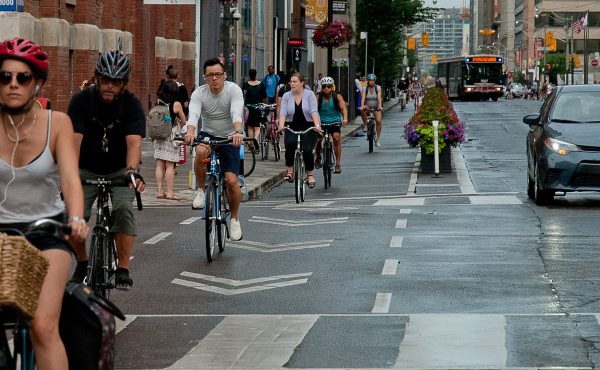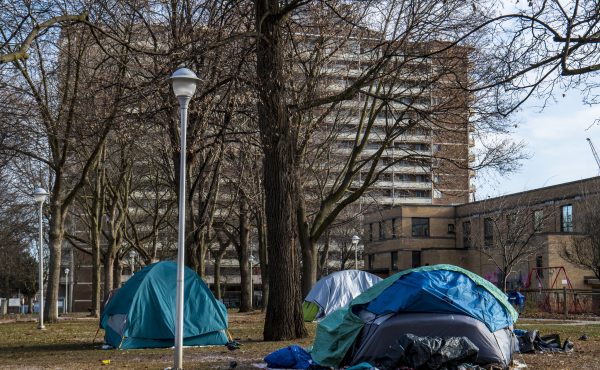Spinning garbage numbers
OK, so Toronto may be slow to build bike lanes. And our transit system could use a lot of work. And, sure, our mayor may not be bold enough to ask drivers to pay tolls for the use of some of our roads. But when it comes to diverting garbage, we Torontonians deserve a pat on the back, right?
We have, after all, adopted the new green-bin program with such unexpected enthusiasm that the city has run out of places to process the organic material that goes into them. And once apartment and condo dwellers jump on the green-bin bandwagon, Toronto will be well on its way to meeting its laudable goal of diverting 100 per cent of its garbage from its new landfill by the year 2010.
Unfortunately, sometimes numbers can be misleading. You see, the goal of diverting all of Toronto’s garbage only refers to the trash that the city is responsible for collecting, which, according to Geoff Rathbone in Solid Waste Management, is only about half of the waste that is actually produced in our fine municipality. The other half, generated by businesses that operate in spaces larger than 500 square metres, is regulated by the province, and handled by private disposal companies. “When [provincial regulations requiring basic recycling] first came out, they were really well enforced,†Rathbone tells me, “but over the last decade people have slacked.†(This might explain why many fast-food restaurants can get away with not providing recycling in their stores.)
So when the mayor talks about diverting all of the city’s garbage, he’s really only talking about diverting half of the trash that Toronto makes. Rathbone says the city has little control over what companies that are regulated by the province do.
The street furniture fiasco keeps on growing
When the city first pitched the coordinated street furniture program to the public, it promised to reduce the total square footage of ad space that currently appears on benches, bus shelters, garbage cans and other pieces of sidewalk infrastructure. But street furniture aficionado Jonathan Goldsbie says the program may actually increase the amount of advertising on our streets by 10 per cent. When the Request for Proposals (RFP) went out last spring, the city estimated there to be 198,200 square feet of street-furniture advertising already on the streets and the RFP specified that advertising levels be no greater than this number.
After the RFP was issued, however, the city gathered more precise data. Based on these numbers, Goldsbie has calculated that the current amount of ad space, in fact, equals 177,958 square feet. This means that if the company that wins the contract uses the maximum amount of advertising space allowed (and why wouldn’t they? Cha-ching!), our sidewalks will see more advertising, not less.





10 comments
Solving the problem of fast food waste isn’t just a matter of providing recycling containers in the stores… they actually have to serve things in recyclable containers! The Fairview Mall food court, for example, has slots for cans and for bottles, but it does no good if most beverages are served in the typical disposable fast food cup.
We’d need to also have a mass conversion of recyclable beverage containers (or reusable ones, like Tim Hortons in-store mugs), and preferably reusable dishes and cutlery. I had lunch at Tim’s this week — my plate, bowl, and cutlery were all washable/reusable, my bottle of juice was recyclable, and the only leftover waste consisted of a couple paper liners and a paper napkin.
I totally agree, Tim. I guess I just get so frustrated when this one thing that stores could do, and are supposed to do (providing recycling bins), to cut down on garbage is just ignored. At the very least, they should be doing this.
Using recyclable containers instead of disposable cups or better yet reusable containers, as you said, would, of course, be best. Kudos to you for bringing your own cutlery and plate and bowl. I wish more people (myself included) did that more often!
It would be nice if “lowest advertising quantity” was weight significantly in the process. A nice ratio of most furniture with the least sq.f. of ads takes the prize.
Just to clarify – it’s actually the Tim’s that supplies the mugs, plates, cutlery etc. I’m not hardcore enough to take my own cutlery everywhere I go! (Although I do have a towel at work so I don’t use paper towels in the washroom…)
Whenever I read that the City is going to offer more recycling boxes, I can’t help but admire the salesmanship of the plastics company that will make a fortune from the sale of millions of plastic containers.
And when those containers are obsolete, hoe do we dispose of them?
George: loved you on “Danger Bay.” Anyway, how does a simple open-topped container become obsolete? Even if we found a way to eliminate the need for recycling programs requiring all those blue, green and grey boxes, we could re-use them all as planters, grow vegetables in ’em.
Seriously, though, and despite what the radio ads say, more recycling does not (necessarily) mean a greener Ontario. Much less so than would a meaningful waste reduction plan. But forget about fast food wrapping, what about buildings? Over 20% of landfill is waste from the demolition or gutting of old buildings. If we could slow or stop the rampant destruction of our reusable, upgradeable, existing built environment, it would do more to fix our problems than a lifetime’s worth of blue-boxing cans and PET bottles.
Looking at the fast food issue after living nearly 3 years in Europe, I think we’ve got some catching up to do.
There when you are finished, you don’t dump all the trash out, rather you slide it into a rack (think of Ikea’s cafeteria – with the racks on wheels). Someone then later splits the various recycling aspects. The other thing I noticed (at least in the German speaking countries), is that if you’re eating in at a McDonald’s and have ordered a drink, they don’t give you a lid unless you ask for it. Does that mean that us in N. America are less coordinated and more prone to spilling our drinks 😉 ?
This reminds me of the recent introduction of TetraPak wines here in Ontario. TetraPak wines are FAR more ecologically friendly than glass bottles. It has caught on in places like Europe and Australia, but not here.
When I mention Tetra Pak wines here, people scoff at the idea. “Only good wine comes in bottles.”, “Bottles are superior in every way”, etc. Despite being completely wrong on both those points, shouldn’t us Canadians be taking a look at the practices of Europe and Australia, areas that are known to know a hell of a lot more about wine than us?
The problem isn’t the infrastructure. It’s the people. Frankly, most people couldn’t give two shits about the environment if it means changing their habits. There’s a serious lack of respect, and that needs to change.
I think Tetra pak wine will catch on here for one stupid lazy reason. They weigh less. I know that many kayakers and outdoors people love them for long trips.
I would like to vote Swiss Chalet as a huge offender in the garbage debate. Their takeout used to have many recycling elements but now there is nothing with their take out that can be recycled. Once in a while we get it but cut back to a few times a year due to the garbage.
And I would like add one comment about our garbage policy. I have had City garbage workers rrefuse to take a chopped up 2×4 (not a reno, just one piece) which will degrade but I can fill my garbage bags with Swiss Chalet plastic that will never decompose. AS many here have said, we need to change things at source.
Something that tends to get forgotten is that recycling can be very energy intensive. It doesn’t divert waste, it reduces some of it, and turns most of it in to emissions.
The answer is less consumption, and more reusability in what we do consume.